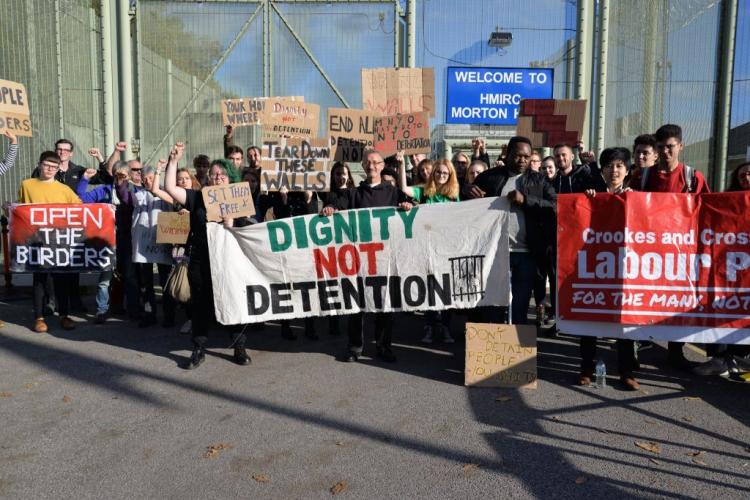Vibrant, Diversifying Civic Mobilization Challenges the Immigration Detention System
Posted:
Time to read:
Guest post by Anna Lindley, SOAS, University of London.
There is a burgeoning research literature critically mapping the spatial and temporal logics of immigration detention and how these systems are increasingly used to discipline and contain ‘unwanted’ mobile populations. But detention centres are also the scene of interaction and resistance. While detainee’s experiences of everyday life, collective organization and protest have been documented to some extent, there is relatively little systematic research on geographies of resistance, particularly on the role of ‘outsiders’ – members of the public with relatively secure status. In a context where detention functions not only to contain but also to exclude migrants from wider society, efforts to cut across these boundaries are of particular interest. What nourishes civic mobilization around immigration detention? There are some 40 groups across the UK working in a significant way on detention: levels of institutionalization vary greatly, as do their goals and ways of working. Drawing on qualitative interviews and survey research (reported in detail in a longer article accessible here), this blog post explores how people come to mobilise and their experiences of taking action.
In terms of how research participants articulated the cause for concern, there were several salient and inter-connecting themes. They were united in identifying the indefinite nature of detention as a significant injustice; in their concern for the significant suffering that the system engenders; and in noting inconsistencies between procedure and practice. To varying degrees, volunteers pushed back against the incarceration of people on administrative - rather than criminal - grounds. Many also set detention within a wider political frame, connecting it with injustices in the national immigration regime and global inequalities. There were some nuances and diversity in volunteers’ preoccupations, but the vast majority of those surveyed were of the view that substantial change to the detention system is needed; the majority favored ending detention and a more open approach to immigration. Of course, this is in a country where opinion polls suggest most of the UK public believe that immigration should be reduced - but is consistent with evidence that restrictive preferences begin to disintegrate when people are confronted with the human costs of bureaucratic controls.

What do we know about the wider world views and characteristics of people mobilizing around immigration detention? ‘Having time’ seems to be - unsurprisingly – an important factor, with many participants being at a point in their lives (often in their twenties or retired) when they have relatively fewer or more flexible responsibilities. Most were left-leaning politically and many felt a sense of moral responsibility associated with relative socio-economic security. For some, faith played an important role. More direct forms of proximity to the issue (living close to detention centres, having social relationships with people detained, and intergenerational or direct experiences of migration and discrimination) may act as potent motivators. Social networks and sociability played an important role in recruitment and motivation.
How does this feed into action? Many volunteers challenged the isolation of people in detention by visiting individuals, spending time with them and trying to support them in various practical ways. Reflecting testimonies collected earlier by the Association of Visitors to Immigration Detainees, visitors talked eloquently of the pleasure of building relationships, and acquiring skills, knowledge and a sense of perspective through this process. At the same time, visiting can be time-consuming, awkward, and emotionally demanding work; and volunteers also talked about the often difficult inter-personal and organisational politics of visiting. Participants were prone to feelings of ‘affective and ethical insufficiency – of not having been or done enough’. Strategies do exist to address some of these challenges, through careful recruitment, training and support systems. Many visitors also support campaigns for change to the detention system, and often organisations feed insights derived from ‘casework’ into advocacy: indeed, much of what we know about detention ‘comes from advocates doing the work of documentation against obscurity, publicity against silence, and challenge against impunity.’
This brings us to a wider plane of action. There are several prominent campaigns: to end detention outright; to improve legal safeguards, particularly via imposition of a time limit; against the detention of particular groups; and for use of alternative mechanisms of immigration control. Although there are some divergences on goals and approaches, both separate campaigns and the conscious search for common ground have created a sense of momentum and enthusiasm among those involved in recent years. Importantly, the detention movement is diversifying, building alliances across different spaces and communities. While people who have been detained in the past and/or who are living at risk of detention have often been fearful and too preoccupied with the demands of everyday life to engage in activism, their voices are becoming stronger in the movement and outside, with powerful public advocacy by groups like Freed Voices, Movement for Justice and Samphire. While there have long been local campaigns around specific detention centres, these are connecting with wider spaces, with the ‘These Walls Must Fall’ campaign working to mobilise support from communities, councils and trade unions across the UK, including in key cities with large populations at risk of detention. National and international networking, alliances and publicity have grown, with the Detention Forum and Association for Visitors to Immigration Detainees bringing together voluntary sector groups; professional medical and legal, humanitarian and human rights organizations weighing in with concerns; hard-hitting media coverage and a barrage of critical official reports in recent years, of which the Home Affairs Select Committee Report decrying the Home Office’s ‘shockingly cavalier attitude’ is only the most recent example. All major opposition parties now pledge reforms including ending indefinite detention.

The detention system can be understood as a set of spatial strategies that function to isolate, contain and exclude people from wider society, creating a sense of moral distance. This system has been normalised as ‘an essential, everyday facet of immigration control’. As we have seen, a vibrant detention movement is working across multiple spaces and scales to challenge this moral distance and political closure. As the government’s immigration policy agenda bites deeper and wider, fuelling deprivation and unease in a diverse society, immigration policies are increasingly impinging on the lives of citizens and secure residents, through personal or family relationships or work roles in public/private service provision. The government’s apparent intransigence on the detention issue is under growing pressure, in a wider political environment that remains highly uncertain, posing both threats to non-citizens and opportunities for change.
Any comments about this post? Get in touch with us! Send us an email, or post a comment here or on Facebook. You can also tweet us.
__________
How to cite this blog post (Harvard style)
Lindley, A. (2019) Vibrant, Diversifying Civic Mobilization Challenges the Immigration Detention System. Available at: https://www.law.ox.ac.uk/research-subject-groups/centre-criminology/centreborder-criminologies/blog/2019/05/vibrant (Accessed [date])
Share:








